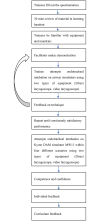Does seniority always correlate with simulated intubation performance? Comparing endotracheal intubation performance across medical students, residents, and physicians using a high-fidelity simulator
- PMID: 34559834
- PMCID: PMC8462689
- DOI: 10.1371/journal.pone.0257969
Does seniority always correlate with simulated intubation performance? Comparing endotracheal intubation performance across medical students, residents, and physicians using a high-fidelity simulator
Abstract
Background: Endotracheal intubation is crucial in emergency medical care and anaesthesia. Our study employed a high-fidelity simulator to explore differences in intubation success rate and other skills between junior and senior physicians.
Methods: We examined the performance of 50 subjects, including undergraduate students (UGY), postgraduate trainees (PGY), residents (R), and attending physicians (VS). Each participant performed 12 intubations (i.e. 3 devices x 4 scenarios) on a high-fidelity simulator. Main outcome measures included success rate, time for intubation, force applied on incisor and tongue, and Cormack Lehane grades.
Results: There was no primary effect of seniority on any outcome measure except success rate and Cormack Lehane grades. However, VS demonstrated shorter duration than medical students using Glidescope and direct laryngoscopy, whereas VS and R applied significantly more force on the incisor in the normal airway and rigid neck scenario respectively.
Discussion: Seniority does not always correlate with skill perfection in detailed processes. Our study suggests that the use of video laryngoscopy enhances the intubation success rate and speed, but the benefit only accrues to senior learners, whereby they applied more force on the incisor at a single peak under difficult scenarios. These findings are discussed in terms of psychological and cognitive perspectives.
Conclusion: Speed and safety are essential for high quality critical medical procedures. A tool should be designed and implemented to educate junior physicians with an emphasis on practice and efficiency, which should also contribute to updating senior physicians' knowledge and competence by providing instant feedback on their performance. This type of fine-grained feedback could serve as a complement to traditional training and provide a sustainable learning model for medical education.
Conflict of interest statement
In this study, Young Tah Instruments Ltd. and Kyoto Kagaku Co.,Ltd. funded for borrowing the simulator: MW13: DAM Simulator Training Model for airway training and curriculum development. This does not alter our adherence to PLOS ONE policies on sharing data and materials.
Figures




References
Publication types
MeSH terms
Associated data
LinkOut - more resources
Full Text Sources

